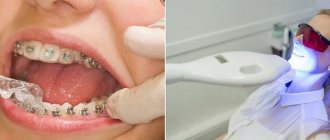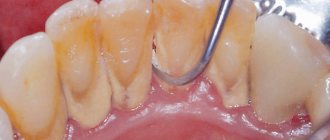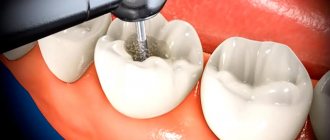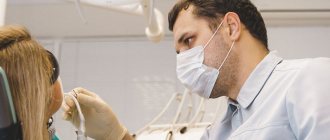Modern methods of obtaining a Hollywood smile make it possible to whiten teeth by 6 to 12 tones, and even remove old pigmented plaque. Procedures using ultrasound, laser, and the Zoom system are painless and safe, and the resulting effect lasts up to 5 years with proper oral care. However, when using even gentle techniques, the sensitivity of dental tissues increases, and the enamel loses part of its natural protection. After teeth whitening, it is very important to maintain your doctor's recommendations. They are aimed at reducing the risks of negative consequences and securing results.
What diet should you follow after whitening?
Before you whiten your teeth, you need to decide to change your diet for the next few weeks. In order for the resulting effect to be consolidated and preserved for a long time, they adhere to a white or transparent diet.
All foods that contain coloring pigments or that can cause darkening of the enamel are excluded from the diet:
- coffee, tea, red wine, juices, hot chocolate, cocoa, sweet sodas;
- beets, pumpkin, carrots, tomatoes, red cabbage;
- blueberries, blackberries, black currants, mulberries, blueberries, grapes, cranberries, pomegranates, raspberries, strawberries, cherries;
- black bread, buckwheat;
- spices with yellow pigment (turmeric, curry), paprika, cinnamon, nutmeg;
- confectionery products with artificial colors;
- liver, heart.
In general, the diet will remain rich, since there are many products and dishes included in the white diet. These include all light vegetables, meat, poultry, fish, milk and dairy products, potatoes, cereals, pasta, nuts, and oils. Among berries and fruits, white grapes, melon, pears, and bananas are neutral. Drinks you can drink are light juices, lightly brewed green tea, and mineral water.
Dental clinic No. 2
This year the summer does not spoil us with warm weather. While walking on a cool evening, you want to go to a cafe and drink a cup of hot tea. However, often in a small cozy room you are greeted by the suffocatingly sweet smell of smoke and tobacco. And you realize that you are in an establishment where the owners offer hookah to visitors. Smoking hookah became fashionable several years ago in our country. It is presented as some kind of trend. Hookah establishments are opening one after another. Most hookah consumers are young people who, out of ignorance or under the influence of advertising, naively believe that hookah is safe for health. Few people think about how hookah affects health. What will happen to the body even after several puffs? The World Health Organization has conducted multilateral studies, the results of which will dispel myths about the safety of hookah.
Myth 1. Tobacco used in a hookah is safe because, passing through water, it is cleansed of harmful substances. According to the World Health Organization, analysis of hookah smoke revealed the presence of carcinogenic substances such as nitrosamins, polycyclic aromatic hydrocarbons, formaldehyde, benzene and toxic substances: nitric oxide and heavy metals. In addition, the very combustion of charcoal used in hookahs generates high levels of carbon monoxide. These toxic substances are related to the occurrence of heart and lung diseases and lead to the development of cancer. The most dangerous among them is benzopyrene. It is this, in combination with carbon monoxide, that destroys the lungs, provokes the rapid growth of cancer and leads to rapid death. A survey of hookah smokers revealed that after three years of hookah smoking, the condition of their lung tissue is 10 years ahead of their passport age. Hookah smokers are at risk of the same diseases as regular smokers. These are: - oral cancer; - lungs' cancer; - stomach cancer; - esophageal carcinoma; - decreased lung function; - impotence; - decreased ability to bear children; - weakened vision. Research has documented increased heart rate and blood pressure, other harmful acute cardiovascular effects, impaired lung function and exercise capacity, increased incidence of pneumonia, fainting, and acute carbon monoxide poisoning in hookah smokers. Being in the company of hookah smokers is equated to passive smoking, having an effect equivalent to being in a room filled with cigarette smoke. In this case, combustion products of charcoal, used as a combustible substance for hookahs, are added in the form of carbon monoxide and other chemical compounds.
Myth 2. When using a hookah, a person absorbs fewer toxic substances. Research has shown that smoking hookah exposes smokers to significant levels of toxic compounds. Hookah tobacco is packaged in 5() gram boxes, each containing 25 mg of nicotine. This amount is enough to fill four hookahs. A simple mathematical calculation shows that each person consumes 6.25 mg of nicotine. To push the smoke through the water, hookah smokers take a deep breath, filling the tiniest alveoli of the lungs with moist tobacco, which contains nicotine, carbon monoxide, heavy metal salts and carcinogens. Over the course of an hour, a hookah smoker takes from 40 to 200 deep puffs, and with each of them, about a liter of smoke enters his lungs.
Myth 3. Smoking a hookah is not addictive. The addiction to hookah is currently significantly underestimated. Nicotine is an addictive substance found in tobacco. It is also present in significant quantities in hookah smoke. The water filter retains some of the nicotine, but does not guarantee the safety of smoking, and therefore smoking a hookah is addictive. Alcoholic drinks are often used in hookahs instead of water. Alcohol vapor passes through the lungs directly into the blood, which over time can lead to alcohol dependence.
Myth 4. Nicotine-free hookah tobacco is harmless. Studies of non-nicotine tobacco and herbal hookahs show that smoke from them contains carbon monoxide and other toxic substances that can increase the risk of cancer, heart disease and lung disease. When passively smoking nicotine-free mixtures, emissions of toxic substances are equal to or even higher than emissions from smoking tobacco-based mixtures. Thus, hookah smoke from tobacco-free products is also dangerous, and in addition to nicotine, it contains the same toxic substances and has the same biological activity as tobacco-based products.
Myth 5. Hookah use does not affect fertility. Any smoking affects the ability to have children. Damage to reproductive function occurs in both women and men. In women who smoke hookah, their childbearing age and menstrual cycle are reduced, which leads to a decrease in the ability to conceive. In men who prefer to smoke hookah, the number of irregularly shaped sperm in the seminal fluid increases and they become inactive. These changes persist for several months. Even if the expectant mother, upon learning of her pregnancy, immediately stops smoking hookah, the risk of birth defects in children remains. Doctors are seriously concerned that hookah smoking is becoming increasingly popular in our country and are trying to inform people about the harm hookahs cause to the body. A person always has a choice of how to spend his free time. Some people enjoy training their bodies in the gym, or helping homeless animals with friends, while others are ready to sit for hours at a hookah and consciously make efforts to destroy their health. Infertility, sick children, oncology, cardiovascular and other diseases - isn't the price too high?
Hygienic care rules
Since the gums and dental tissues become more sensitive and weakened during the first few weeks, special hygiene requirements must be observed:
- Replacing the brush. Bacteria accumulate on the bristles over time, so it is recommended to change the dental plaque removal tool once every three months. After the whitening procedure, this must be done immediately, as the gums and enamel may be slightly injured. Even small cracks will become a path for pathogens to penetrate inside. You need to buy a brush with soft bristles, and after a few weeks replace it with a harder one.
- Competent selection of toothpaste. Products are chosen with low abrasiveness. This indicator indicates the strength of plaque abrasion, or, more simply, hardness. In the specifications it is indicated by the abbreviation RDA. It should be within 30 - 50 units. To strengthen the surface layer and saturate the enamel with microelements, pastes with fluoride or calcium are chosen. The higher the percentage of these substances, the better. If gum sensitivity is increased, then buy restorative gels with herbal extracts.
- Mouth rinses. After eating, be sure to rinse your mouth with clean water or mouthwash. If there is inflammation of the gums, use safe antiseptic solutions: Chlorhexidine, Miramestin, Rotokan. Do not rinse with herbal decoctions, as they can stain.
- Comprehensive care. To maintain hygiene at a high level, additional devices are used: interdental brushes, flosses, irrigators. If teeth have been additionally cleaned to remove supragingival or subgingival calculus, anti-inflammatory and regenerating drugs are applied to the gums, for example, Metragil Denta.
In order to always have white and healthy teeth, you need to undergo professional oral hygiene at the dentist once every six months.
Changes in enamel color in smokers
In the process of smoking a cigarette, smoke enters the human body, which contains tar, nicotine and combustion products. They stick tightly to tooth enamel, staining it an unnatural color. Smokers often have yellow or brown teeth. In this case, localized areas of enamel staining in the form of spots or lines may be observed, indicating the most affected areas.
Features of stains on enamel:
- in the spaces between the teeth - a sign of the formation of tartar, which accumulates a greater amount of coloring substances due to its porous structure;
- along the gum line - a sign of recession, characterized by weakening of the gums, exposure of the neck of the teeth and inflammation of the soft tissues;
- the inner side of the dentition - signals an increased acidic environment as a result of the interaction of saliva and cadmium sulfate (a product of burning a cigarette), the formation of tartar and inflammation of the gums.
Long-term smoking leads to the penetration of dyes deep into the tissue of the dental crown. Not only enamel is negatively affected, but also hard tissues up to dentin. Therefore, the only solution to restore a snow-white smile is professional whitening.
Bleaching and smoking IQOS
After bleaching, it is not recommended to smoke cigarettes, drink strong tea, coffee, or eat foods with dyes, as excessive staining of teeth is possible within one week. Your daily diet should include foods high in calcium and fluoride, namely dairy products, eggs and fish. And, conversely, from your daily diet you need to exclude foods that can stain the enamel, for example, coffee, berries, juices. It is also recommended to eat solid and hot foods. The longer the patient adheres to the diet and does not consume dyes, the longer the whitening effect lasts. After the procedure, you can ask your dentist whether you can smoke IQOS cigarettes after brushing your teeth, what products are allowed for consumption, and when to come for the next session. Usually the specialist asks you to refrain from smoking in all its forms for some time, including the use of electronic cigarettes and IQOS.
Scientists have conducted studies in which they found that in the case of regular smoking, after bleaching, the particles contained in cigarettes quickly darken the enamel. The same method was applied to the teeth using IQOS systems. In this case, virtually no darkening was observed.
However, to minimize the risk of unwanted effects on enamel, it is recommended to wait a few hours before using IQOS. You should give up regular cigarettes for a couple of days, ideally 3-5, and only then start smoking.
If it is impossible to quit smoking tobacco for a few days, then it is better not to undergo teeth whitening. Its effectiveness will decrease several times if you do not follow the recommendations of dentists in the future. Permission to smoke IQOS is obtained not only after bleaching. You can also find out from your dentist whether you can smoke IQOS after tooth extraction, treatment of caries, periodontitis, or pulpitis.
Most often, in addition to whitening, people ask the question of whether it is possible to smoke IQOS after tooth extraction. The dentists’ answer here is clear: no, because there is an open wound in the mouth, which is not recommended to be exposed not only to smoke, but also to steam. You should distract yourself from the thought of smoking for at least 2-3 hours.
After cleaning, you should refrain from smoking IQOS for 2 hours, since as a result of removing tartar, an unprotected gap sometimes appears between the tooth and gums.
Reviews from users of the electronic tobacco heating system indicate isolated unpleasant sensations that occur when consuming IQOS immediately after brushing your teeth, but these are rather personal impressions.
Thus, using IQOS is much less harmful than consuming regular cigarettes. This applies to general health and the direct impact of IQOS on teeth. It is important to follow the recommendations of dentists and not harm your own health.
Procedure technology
The method of restoring the whiteness of teeth is selected by the dentist based on the results of an instrumental examination. Regardless of the choice, the mandatory recommendation is to adhere to a “white” diet. Within 10 days from the moment of bleaching, the patient excludes liquids and foods indicated by the doctor from the diet. This is done to consolidate the achieved therapeutic effect.
In addition to the ban on smoking, the patient is advised to give up colored foods. These include:
- strong coffee and tea;
- cocoa-containing drinks;
- pure chocolate;
- chocolate products;
- wine (white and red);
- ice cream with dyes;
- fresh vegetables with bright colors;
- sauces made from products with a distinct color.
Of course, it is impossible to completely exclude all of the above from the diet. The main thing is to refrain from using it during the first 2 days from the day of the procedure.
After the specified time, minor consumption of the indicated is allowed. After eating, be sure to brush your teeth and rinse your mouth with hygienic balm.
Addiction to tobacco products has a destructive effect on the entire body. If the lungs, gastrointestinal tract, blood supply system, unequal system, and so on are gradually destroyed, then the teeth take the blow much faster.
Tobacco resins chip off the enamel, making it an unpleasant color. At first, a whitening paste solves the problem, but after six months professional whitening is required.
Recommendations
We list the basic rules of care after the lightening procedure:
- Following a diet (discussed in detail below).
- Cleaning should be done not twice a day, but after meals. Its duration increases to 5 minutes, but you must avoid pressing hard on the brush.
- Choosing a toothpaste. It is recommended to use pastes that reduce sensitivity and have the ability to block pain signals. They can be alternated with pastes containing fluoride and calcium. For the first time, it is better to avoid whitening pastes with an aggressive abrasive effect. Their use is encouraged to maintain the effect, but only two weeks after office lightening.
- The brush should be soft and not damage fragile enamel.
- Rinse aids. To strengthen tooth enamel, you need to use rinses containing fluoride in a concentration of about 250 ppm.
- Dental floss should be used constantly after meals. It allows you to remove food debris from the interdental spaces.
- Smoking. Is it possible to smoke after whitening? This is strictly prohibited for several hours; it is better to completely quit smoking in the first days. If a person is a heavy smoker, regular cigarettes should be replaced with electronic ones.
Special cases of using bleaching agents
In patients with metabolic disorders and a tendency to bad habits, there is a need to use special means. When smoking after bleaching, pathological changes occur much faster. The culprit is a combination of an existing disease and a craving for cigarettes. As soon as 2 problems combine forces, irreparable damage is caused to health.
That is why dentists and therapists urge people to be more attentive to their own health. It is impossible to quickly quit a cigarette, so after smoking it is imperative to adhere to the following procedure:
- rinse the mouth with boiled water;
- brush your teeth thoroughly - use a product prescribed by the dentist based on the results of the examination;
- rinse the mouth with a hygienic solution - it is recommended to use liquids based on fluoride or forest herbs;
- treat teeth with dental floss - the duration of this procedure is from 4 to 6 minutes.
What can replace hookah?
If you have a habit such as hookah smoking, then you don’t have to visit special places or buy a bulky device for your home. It is much more convenient to buy an electronic hookah, which is steadily replacing traditional hookahs and cigarettes. Advantages of this alternative:
- The pricing policy for classic hookahs is much higher.
- An electronic hookah can be considered a pocket-sized one and can be used everywhere.
- You no longer have to spend a lot of money on hookah tobacco.
- The electronic hookah does not require cleaning immediately after use.
You can choose the design and flavor you like, and easily take the e-hookah with you on your travels. In this case, the body will receive fewer toxic substances, and the people around you will not be at risk from tobacco smoke in the air.
How does the procedure affect the teeth?
Professional whitening occurs due to a combination of two factors:
- The action of hydrogen peroxide. The substance penetrates the enamel and causes an oxidation reaction, as a result of which coloring pigments are destroyed.
- Exposure to ultraviolet, halogen lamps, LEDs or laser beams. This is necessary to speed up the reaction and make the procedure more effective.
Using professional methods, it is possible to lighten the enamel by 8-12 tones, but at the same time two unfavorable factors are affected at once - chemicals and heat. After such intervention, teeth become vulnerable:
- Under the influence of acid, enamel becomes thinner and becomes loose.
- Sensitivity increases.
- Possible soft tissue irritation.
- Demineralization occurs. Enamel devoid of minerals is prone to the appearance of carious cavities.
Using professional methods, you can lighten the enamel by 8-12 tones.
Care after chemical teeth whitening has two goals - long-term preservation of the effect and strengthening of weakened enamel to prevent the development of its diseases.








